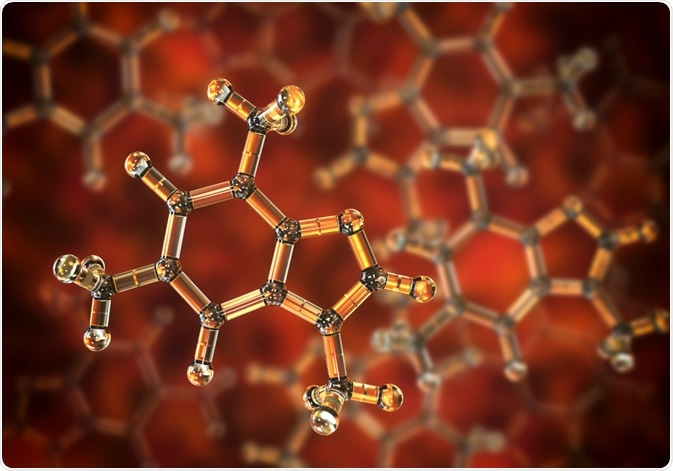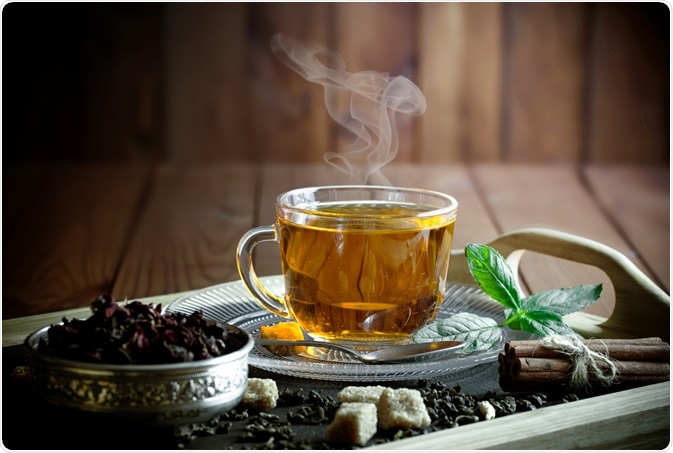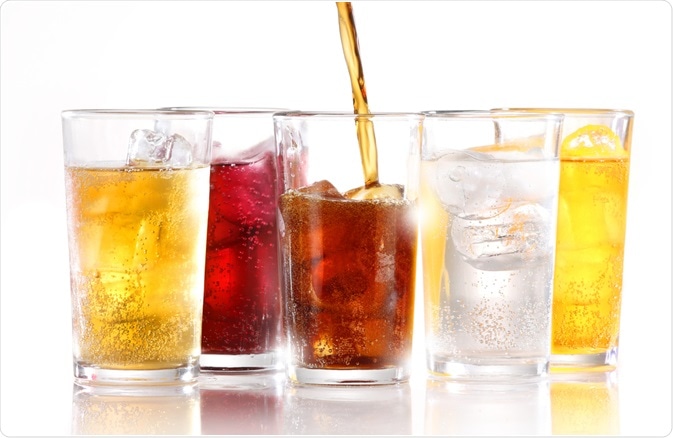Caffeine is a psychoactive drug and a stimulant of the methylxanthine class that affects the central nervous system (CNS). A legal and popular substance in everyday culture, caffeine reversibly blocks adenosine receptors to prevent the onset of drowsiness and improve cognitive function.

Image Credit: Kateryna Kon/Shutterstock.com
The primary ingredient in the coffee bean is caffeine and through a process of infusion, it can be extracted to make several hot and cold drinks. Caffeine-containing drinks include coffee, tea, and various soft drinks including energy drinks.
The typical daily dose of 400 - 500 mg per day (approximately four cups) is well below the toxic levels of 10 grams per day for an adult. Adults consume approximately 160 mg of caffeine per day. A standard cup of coffee contains around 130 mg of caffeine on average depending on the method of preparation.
Hence, it requires approximately 75 standard cups on average to reach toxic levels. While there are several methods of determining the levels of caffeine in hot and cold drinks, a common method used is high-performance liquid chromatography (HPLC).
Benefits of Caffeine
Normal doses of caffeine generally improve reaction time, alertness, concentration, and motor skills. It also has the added benefit of delaying drowsiness and improving task performance during sleep deprivation.
The amount of caffeine required to produce these beneficial side effects vary amongst people with different body size and tolerance. These effects appear generally up to an hour after consumption and can last up to four hours.
Caffeine has also been used to treat various medical conditions. It may improve weight gain during therapy and reduce the incidence of cerebral palsy. Also, it could help reduce problems with language and cognition. Hot drinks containing caffeine such as coffee and tea have been used to help improve airway function in people with asthma.
Moreover, the levels of caffeine in a cup of coffee in the range of 100 – 130 mg has the potential for improving pain relief when combined with paracetamol or ibuprofen. Other benefits in muscular performance and exercise have been noted.

Image Credit: Formatoriginal/Shutterstock.com
Caffeine in Coffee
The primary source of caffeine comes from the coffee bean and is generally brewed. The levels of caffeine in coffee is variable depending on the method of preparation and the type of coffee beans used. Typically, the serving size for brewed coffee is around 100 mg on average, where a single shot of espresso is 30 ml and a cup of coffee being 120 ml.
Additionally, the caffeine content in dark-roast coffee is slightly lower than the lighter roasts due to the roasting process reducing the caffeine concentration of the coffee bean. Moreover, instant coffee generally contains less caffeine than other types with around 60 mg on average.

Image Credit: Zadorozhnyi Viktor/Shutterstock.com
Caffeine in Tea
Tea is another popular hot beverage consumed around the world. Although it contains more caffeine than coffee by dry weight, it contains less per equivalent serving. Together, tea and coffee are the main sources of dietary consumption of caffeine.
Like coffee, tea contains a variable amount of caffeine depending on growing conditions and processing techniques. Different types of tea contain varying levels of caffeine. Green tea is unfermented and is prepared from young leaves being exposed to steam and high temperatures to inactivate enzymatic oxidation.
In contrast, black tea is fully fermented and is prepared by dehydration of the leaves and stems followed by fermentation by enzymatic oxidation. White tea is also unfermented and is subjected to a minimum amount of processing, which involves picking the leaves before the buds have fully opened and therefore has not undergone oxidation.
The levels of caffeine in green, black and white tea can have a range of 18 – 25 mg/g, 14 – 35 mg/g, and 21 – 31 mg/g, respectively. In contrast, caffeine levels in herbal tea is typically not detected. Previous studies have shown that consecutive brews of tea can reduce the amount of caffeine released after each brew. The average caffeine released from three consecutive brews was 69%, 23%, and 8%, respectively.
Additionally, the amount of caffeine released using tea bags compared to loose leaf tea is higher. It was reported that after three cups of tea were brewed using three tea bags compared to three successive brews using loose leaf tea, approximately twice the amount of caffeine was released.

Image Credit: Charlie Edwards/Shutterstock.com
Caffeine in Soft Drinks
Soft drinks, such as cola, commonly contain levels of caffeine. However, the typical levels of caffeine in soft drinks is roughly 0 – 55 mg per standard 330 ml can.
The caffeine in these drinks is either from the ingredients used to make the drink or as a by-product of the process of decaffeination.
Caffeine intake by children and adolescents is largely from the consumption of soft drinks. In contrast, coffee remains the greatest source of caffeine in adults aged 18 years and older.
References
- Nehlig A, Daval JL, Debry G (1992). "Caffeine and the central nervous system: mechanisms of action, biochemical, metabolic and psychostimulant effects". Brain Research. Brain Research Reviews. 17 (2): 139–70.
- Mitchell DC, Knight CA, Hockenberry J, Teplansky R, Hartman TJ (2014). "Beverage caffeine intakes in the U.S". Food and Chemical Toxicology. 63: 136–42.
- Heckman MA, Weil J, De Mejia EG (2010). "Caffeine (1, 3, 7-trimethylxanthine) in Foods: A Comprehensive Review on Consumption, Functionality, Safety, and Regulatory Matters". Journal of Food Science. 75 (3): R77–R87.
- Nehlig A (2010). "Is caffeine a cognitive enhancer?". Journal of Alzheimer's Disease. 20 Suppl 1: S85–94.
- Poleszak E, Szopa A, Wyska E, Kukuła-Koch W, Serefko A, Wośko S, Bogatko K, Wróbel A, Wlaź P (2016). "Caffeine augments the antidepressant-like activity of mianserin and agomelatine in forced swim and tail suspension tests in mice". Pharmacological Reports. 68 (1): 56–61.
- Snel J, Lorist MM (2011). "Effects of caffeine on sleep and cognition". Progress in Brain Research. 190: 105–17
- Schmidt B, Roberts RS, Davis P, Doyle LW, Barrington KJ, Ohlsson A, Solimano A, Tin W (May 2006). "Caffeine therapy for apnea of prematurity". The New England Journal of Medicine. 354 (20): 2112–21.
- Schmidt B, Roberts RS, Davis P, Doyle LW, Barrington KJ, Ohlsson A, Solimano A, Tin W (November 2007). "Long-term effects of caffeine therapy for apnea of prematurity". The New England Journal of Medicine. 357 (19): 1893–902.
- Schmidt B, Anderson PJ, Doyle LW, Dewey D, Grunau RE, Asztalos EV, Davis PG, Tin W, Moddemann D, Solimano A, Ohlsson A, Barrington KJ, Roberts RS (January 2012). "Survival without disability to age 5 years after neonatal caffeine therapy for apnea of prematurity". JAMA. 307 (3): 275–82.
- Alfaro TM, Monteiro RA, Cunha RA, Cordeiro CR (March 2018). "Chronic coffee consumption and respiratory disease: A systematic review". Clin Respir J. 12 (3): 1283–1294.
- Welsh EJ, Bara A, Barley E, Cates CJ (2010). "Caffeine for asthma". Cochrane Database Syst Rev (1): CD001112.
- Derry, Christopher J; Derry, Sheena; Moore, R Andrew (2014). "Caffeine as an analgesic adjuvant for acute pain in adults". Cochrane Database of Systematic Reviews (12): CD009281.
- Pesta DH, Angadi SS, Burtscher M, Roberts CK (2013). "The effects of caffeine, nicotine, ethanol, and tetrahydrocannabinol on exercise performance". Nutrition & Metabolism. 10 (1): 71.
- Hicks MB, Hsieh YH, Bell LN (1996). "Tea preparation and its influence on methylxanthine concentration". Food Research International. 29 (3–4): 325–330.
- Sajilata, M. G., Bajaj, P. R., & Singhal, R. S. (2008). Tea polyphenols as nutraceuticals. Comprehensive Reviews in Food Science and Food Safety, 7(3), 229-254.
- Silvia Amelia Verdiani, Tfouno, Maíra Marcuci, Camara, Kamille, Kamokata, Fernanda Moralez Leme, Gomes, Regina Prado Zanes, Furlano. (2018), “Caffeine in teas: levels, transference to infusion and estimated intake”. Food Sci. Technol, Campinas, 38(4): 661-666
Further Reading